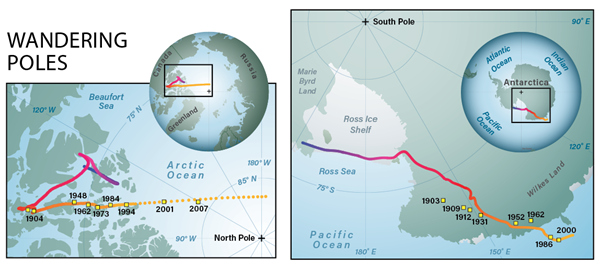Earth’s magnetic field changes over time. In particular, over thousands of years, the locations of the magnetic dip poles tend to wander around in the vicinity of the geographic north and south poles. Occasionally, the field’s intensity will diminish, and the dip poles will stray far from the geographic poles. Sometimes the dip poles will even swap hemispheres — in which case the polarity of Earth’s magnetic field will have reversed. This does not happen periodically; in some ways, reversals occur randomly, the result of chaotic dynamics in Earth’s core. The last time Earth’s geomagnetic polarity reversed was about 780,000 years ago.

Bringing the universe to your door. We’re excited to announce Astronomy magazine’s new Space and Beyond subscription box – a quarterly adventure, curated with an astronomy-themed collection in every box. Learn More >>.
For a geomagnetic polarity that is reversed compared with the present polarity, compasses would tend (roughly) to point south!
Lately, scientists have noted that the north dip pole, presently located off the coast of northern Canada, has been migrating toward Siberia at about 34 miles (55 kilometers) per year. Compared with the rate at which the north dip pole has moved in the previous couple hundred years, the present rate is relatively fast. To top it off, the intensity of the field has decreased by about 10 percent over the past 150 years. This has led to speculation that Earth’s magnetic field is about to reverse its polarity.
But let’s step back and consider a few more facts. While the north dip pole is, for now, moving rather rapidly, the south dip pole is not. And although geomagnetic intensity has been decreasing lately, we know from paleomagnetism (magnetization preserved in rocks) that the present intensity is about equal to the long-term average.
Considering all this evidence together and recognizing that the behavior of Earth’s dynamo is difficult to predict, we cannot confidently say that our planet’s magnetic field will soon reverse. We also know from paleomagnetism that reversals don’t happen periodically. They occur rather randomly in time — about once every half-million years or so (on average) — and, typically, a reversal takes a few thousand years to be completed.
Reversals haven’t had any apparent effect on the global environment, they don’t affect the motion of the continents, and they are not affected by the Sun.
If humankind survives into the distant future and finds itself amid a reversal, the impact on compass-based navigation will likely be accommodated by technological progress. Beautiful displays of aurorae, usually seen only at high latitudes at night and during magnetic storms, might be visible at lower latitudes. Unfortunately, I don’t think I’ll live long enough to enjoy such a spectacle.










